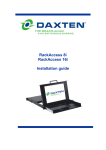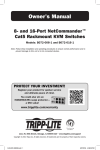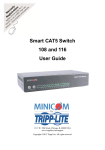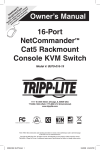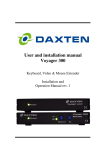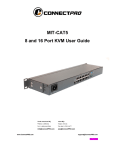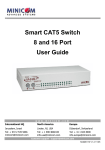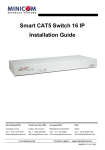Download Daxten SCOUTUTP - Installation guide
Transcript
Installation guide Specifications Part No’s 1018-108 1018-116 Switches SCOUTutp 8 port Switch SCOUTutp 16 port Switch 2364-01P 2364-01U 2364-01S CPU Adaptors SCOUTutp PS/2 CPU adapter SCOUTutp USB CPU adapter SCOUTutp SUN CPU adapter SCOUTutp Height Width Depth Weight SCOUTutp 8 port 4.15cm / 1.63” 21.5cm / 8.46” 12.20cm / 4.80” 0.92 kg / 2.0 lb SCOUTutp 16 port 4.15cm / 1.63” 21.5cm / 8.46” 12.20cm / 4.80” 0.92 kg / 2.0 lb Operating Temperature: 0~40° C ( 32 ~ 104° F) Storage Temperature: -40~70° C (-40 ~ 158° F) Humidity: 80% RH non-condensing Operating Systems DOS, Windows (9X, NT4, 2000, XP, 2003 Server) LINUX, UNIX, QNX, SGI, FreeBSD, BeOS, Open VMS, Novell, Alpha UNIX, HP UX, SUN Mouse PS/2, Wheel mouse, Intellimouse, 5-button mouse Resolution 1600x1200@85Hz Transmission distance Up to 10m (33ft) Power supply Internal switching 85-260 VAC 50 / 60 Hz Connections System RJ45 Serial RJ11 Local KVM HDD15 / PS/2 - MinDin6 / PS/2 - MiniDin6 CPU Adaptors PS/2 USB SUN Video HD15 HD15 HD15 Keyboard/Mouse MiniDin6 USB MiniDin8 System RJ45 RJ45 RJ45 Power From computer’s Keyboard port From USB port From computer’s Keyboard port Connections Product weight 107g / 0.23lb Shipping weight 300g / 0.66lb Dimensions 91 x 41 x 24mm / 3.58 x 1.61 x 0.94” NOTE: This equipment complies with the requirements of European EMC directive 89/336 EEC in respect of EN55022 Class B, EN 50082-1 and EN 60555-2. This equipment has been found to comply with the limits for a Class A digital device, pursuant to Part 15 of the FCC Rules. These limits are designed to provide reasonable protection against harmful interference when the equipment is operated in a commercial environment. This equipment generates, uses, and can radiate radio frequency energy and, if not installed and used in accordance with the instruction manual, may cause harmful interference to radio communications. Operation of this equipment in a residential area is likely to cause harmful interference in which case the user will be required to correct the interference at his own expense. © Copyright 2004. All rights reserved. Daxten, the Daxten logo, SCOUTutp and The Brains Behind KVM Switching and Sharing are trademarks of Daxten Industries. All other trademarks acknowledged. Revision 1.1 SCOUTutp Introduction Thank you for purchasing the SCOUTutp KVM Switch. This product will ensure easy and accurate control over 8 – 16 PCs from a single console. The SCOUTutp is compatible with PS/2, USB and SUN style computers with its specific adapters. It has keyboard and mouse emulation for error free bootups and supports a wide variety of mice including the Microsoft Intellimouse. The SCOUTutp supports high resolutions of up to 1600 x 1200 without any deterioration of the image quality. Switching between PCs can be accomplished through keyboard Hot Key commands, the front panel or through the OSD (On-Screen-Display). Product Features ¾ ¾ ¾ ¾ ¾ ¾ ¾ ¾ ¾ ¾ ¾ Allows a user to control 8 - 16 computers from one console. Supports PS/2, USB and SUN computers through an adapter for each platform 1U Rack mountable Distance between console and computer can be up to 10m with simple CAT5 cabling No drivers or additional software are required for operation. Keyboard and mouse emulation allows for error free boot-up. Supports video resolutions of up to 1600 x 1200 @ 85Hz. Supports VGA, SVGA and XGA monitors. Keyboard Hot Key, OSD control or the front panel. Comes with Auto-Scan mode for convenient automatic switching. Front panel status LEDs give a clear indication of the active PC. Installation Before connecting your computers and console devices to the SCOUTutp switch, please ensure that all devices are powered off. 1. Connecting the console devices with SCOUTutp: Connect your monitor’s HD 15-pin connector to the SCOUTutp’s Monitor connector on the rear panel. Connect your PS/2 keyboard to the PS/2 keyboard connector (purple) and your PS/2 mouse to the PS/2 mouse connector (green) on the rear panel of the SCOUTutp. 2. Connecting the computers with an UTP patch cable and a PS/2 adapter : Connect the blue HD 15-pin male connector to the VGA port on your computer. Connect the purple PS/2 (6-pin Mini DIN) keyboard connector to the PS/2 keyboard port on your computer. Connect the green PS/2 (6-pin Mini DIN) mouse connector to the PS/2 mouse port on your computer. Connect the UTP cable with the PS/2 adapter and the desired SCOUTutp computer port. 3. Connecting the computers with an UTP patch cable and a USB adapter: Connect the blue HD 15-pin male connector to the VGA port on your computer. Connect the USB connector to a USB port on your computer. Connect the UTP cable with the USB adapter and the desired SCOUTutp computer port. 4. Connecting the computers with an UTP patch cable and a SUN adapter: Connect the blue HD 15-pin male connector to the VGA port on your computer. Connect the SUN connector to the keyboard & mouse port on your computer. Connect the UTP cable with the SUN adapter and the desired SCOUTutp computer port. 5. Power up the SCOUTutp Using the SCOUTutp Note: Before switching your computers on, please configure non PS/2 computers emulation type in the OSD! The SCOUTutp provides three possibilities to select the desired computer. You may use either the Select button on the unit, the keyboard Hot Key commands or take advantage of the OSD (OnScreen-Display). You may notice that the mouse cannot be used for around 1 second when the SCOUTutp switches to another computer. This is normal and is caused by the synchronization process which ensures that the mouse operates correctly. Keyboard Hot Key commands To send Hot Key commands to the SCOUTutp switch, press and release the Ctrl key twice within 2 seconds. Press a command key for the desired effect. The following commands are supported: First Key Ctrl Second Key Ctrl Command Key Port number Confirmation Key Enter Command Result Switches to the desired PC In Auto-Scan mode, the image shown on the monitor will automatically switch to the next computer. The delay is user definable OSD (On-Screen-Display) To access the OSD, press the Hot Key twice and the OSD window appears: Lines with blue text show active computers, lines with grey text show inactive computers. To navigate up and down use the UP and DOWN arrow keys. To jump from one column to another (in Settings) use the Tab key. Port No. 01 02 03 04 05 06 07 08 Computer Name SUN PS/2 1 SCOUT SUN PS/2 3 USB USB PS/2 4 No. 01 02 03 04 05 06 07 08 C = computer S = switch C C S C C C C C blue grey grey blue blue grey grey blue After you have selected a computer press Enter . A confirmation label appears showing which computer you accessed. To exit the OSD or return to a previous window within the OSD press ESC . Note: When you use the OSD you can’t use the keyboard Hot Keys at the same time. OSD Settings Press F2 and the setting window will appear. When the OSD is password protected only the administrator has access to this window. OSD Settings General Ports Time Users Security General Settings Select General and press ENTER , the General Settings window will appear. From this window you can do the following: Security The OSD comes with an advanced password security system with 3 different security levels. Each security level has different access rights to the system and have are limited in number as shown below. General Settings Security Hotkey Autoskip Serial port Keyboard language Switch name 1 x Administrator (Status A) Set and modify all Passwords and security profiles Fully access any computer Access all OSD functions 1 x Supervisor (Status S) Fully access any computer Access the following OSD functions only – F4 Scan, F5 Tune and F6 Moving the Confirmation label. 6 x User (Status U) Each User has a profile set by the Administrator that defines the access level to different computers. Activating password protection Only the Administrator can password-protect or disable the protection of the OSD as follows: 1. 2. 3. Navigate to the Security line and press the Space Bar to toggle between On and Off. The password box appears. Type the Administrators password (default password is admin). Press Enter Hot Key Press the Hot Key and the OSD appears. To change the Hot Key to [ Ctrl Ctrl ] (CL on display), [Ctrl , F11 ], [Shift , Shift ] (SH on display) or Print Screen. Press the Space Bar to toggle between the different options. Once selected, press the new Hot Key to display the OSD in the future. Autoskip To access only the active computer lines on the OSD you can use this feature. To activate the Autoskip toggle between the options with the Space Bar. Serial port Serial port ON means the Control Management program can be used. To change the Serial port settings, navigate to the Serial port line and toggle between the options using Space Bar. Keyboard language The default is US English which can be changed to German (DE) or French (FR) as follows: Navigate to the Keyboard language line and toggle between the options using the Space Bar. Switch name You can substitute up to 18 characters in the line. A space constitutes a character. Give each switch’s OSD a different name. Factory Default To return to the factory default Settings you have to press F7 and all changes will be removed. Ports PORTS SETTINGS In the Settings window navigate to the Ports line and press ENTER. The Ports Settings window appears. Name (Editing the computer name) In this window you can edit the computer names with up to 15 characters. To erase a character you have to select it and then press the Space Bar. Blank spaces remain in place of the character. To erase an entire line place the cursor at the beginning of the line and press the space bar until the line is erased. Name 01 02 03 04 05 06 07 08 COMPUTER COMPUTER SWITCH COMPUTER COMPUTER COMPUTER COMPUTER COMPUTER 01 02 03 04 05 06 07 08 KB HKEY PS U1 PS PS U2 U3 PS PS NO NO CLF11 NO NO NO NO NO (KB) Keyboard The SCOUTutp operates with Windows, Linux, HP UX, Alpha UNIX SGI, DOS, Novell, MAC, USB or Open VMS. By default the keyboard mode is set to PS for Intel based computers. For the other systems set the KB column as follows: PS Standard keyboard, MAC and SUN U1 for HP UX U2 for Alpha UNIX, SGI, Open VMS U3 IBM AIX Adding/changing a Hot Key (HKEY) If you cascade the SCOUTutp by connecting another SCOUTutp Switch to a computer port instead of a computer, you have to connect the utp cables to the new switch and you have to define the HOT KEYS for the new OSD. When you cascade these hotkeys must be different for the top and bottom layers. To add/change a hotkey: 1. 2. On the line to which the Switch is connected, press Tab to jump to the HKEY column. Toggle between the options using the space bar. Time Settings Time Settings NAME SCN LBL 01 COMPUTER 030 030 02 COMPUTER 030 030 03 SWITCH 030 030 Scan (SCN) - Label (LBL) - Time out (T/O) 0 4 COMPUTER 0 3 0 0 30 SCN - In the SCN column, changes the scan 05 COMPUTER 030 030 period. LBL - In the LBL column, changes the display 06 COMPUTER 030 030 period of the OSD label showing which 07 COMPUTER 030 030 computer is currently accessed. 08 COMPUTER 030 030 T/O - When password protection is activated you can automatically disable the Management keyboard, mouse and screen after a preset time of non-use. Set this Timeout period in the T/O column. In the Settings window navigate to the Time line and press ENTER. The Time Settings window appears T/0 030 030 030 030 030 030 030 030 To set the above periods: 1. On the desired line press Tab to jump to the desired column. 2. Place the cursor over one of the 3 digits and type a new number. Enter a leading zero where necessary. For example, type 0 4 0 for 40 seconds. Typing 9 9 9 in the LBL column displays the label continuously. Typing 0 0 0 – the label will not appear. Typing 9 9 9 in the T/O column disables the Timeout function. Typing 0 0 0 – the Timeout function works immediately. We recommend a T/O setting of at least 10 seconds. Typing 9 9 9 in the SCN column displays the screen for 999 seconds. Typing 0 0 0 – the computer screen is skipped. Users In the Settings window navigate to the Users line and press Enter . The Users Settings window appears. Turn on the Security feature (under OSD Settings) to configure any Users Settings. There are 3 different access levels. These are: Y – Full access to a particular computer. Plus access to the F4 , F5 and F6 OSD functions V –Viewing access only, to a particular computer (No keyboard/mouse functionality) N – No access to a particular computer – A TIMEOUT label appears if access is attempted 01 02 03 04 05 06 07 08 USERS SETTINGS USERS 1 2 3 COMPUTER 0 1 Y Y Y COMPUTER 0 2 V V Y SWITCH 03 Y Y Y COMPUTER 0 4 V V V COMPUTER 0 5 N N Y COMPUTER 0 6 V V N COMPUTER 0 7 Y Y Y COMPUTER 0 8 Y Y Y 4 V Y Y V N N Y Y 5 N N Y V N N Y Y 6 V V Y V V V Y Y To give a user the desired access level, navigate to the desired computer line and USER and toggle between the options using the space bar. Security In the Settings window navigate to the Security line and press Enter . The Security Settings window appears. In the window above you can see the Name of the User, his password and the type of the password. To change a user name or password you have to navigate to the desired line and column. Type a new user name or password. User authentication is done solely via the password. There is no security significance to the names. SECURITY SETTINGS NAME PASSWORD ADMINISTRATOR ADMIN SUPERVISOR S USER 1 USER 2 USER 3 USER 4 USER 5 USER 6 T A S U U U U U U The OSD HELP window – F1 To access the HELP window press F1 . The HELP window appears: Please note! All the functions set out in the Help window are performed from the Main window. The Help window is merely a reminder of the hotkeys and their functions. Scanning computers– F4 Where necessary adjust the scan time in the Time Settings window, see above. To activate scanning: Press the Hot Key twice to open the OSD. Press F4 . Your screen displays each active computer sequentially, with the Scan label appearing in the top left corner. Press F4 to deactivate scanning: Tuning – F5 You can tune the image of any remote computer screen from the Select Computer window. To adjust the screen image: Navigate to the remote computer you wish to adjust. Press F5 . The screen image of the selected computer appears, together with the Image Tuning label. Adjust the image by using the Right and Left Arrow keys, when the image is satisfactory, press Esc . Note! Picture quality is relative to distance. The further away a remote computer is from the SCOUTutp, the lower the image quality, and the more tuning needed. Place the higher resolution computers closer to the main unit. Moving the label – F6 Position the OSD label anywhere on the screen. To position the OSD label from the Main window, navigate to the desired computer using the Up and Down arrow keys. Press F6 . The selected screen image and Identification label will appear. Use the arrow keys to move the label to the desired position. Press Esc to save and exit. Using the Control software As an alternative to the OSD you can operate the SCOUTutp system with the Control software located on the Marketing & Documentation CD. With the OSD you operate the system and view the computer screens on the same monitor. The Control software requires 2 monitors 1 for the software and 1 to view the computer screens. With the Control software you can: -View computers -Edit OSD Settings -Save configurations for future use -Read and write configurations to the SCOUTutp Switch Control software system requirements Pentium 166 or higher computer, 16Mb RAM, Windows 98 and later, a free Serial port Connecting the serial download cable To run the software, connect the serial cable to the computer containing the software, and to the SCOUTutp. Note! The system must be fully connected BEFORE running the Control software. Failure to connect the system first will lead to the software working in demo mode. To install the software: Insert and start the Marketing & Documentation CD. ¾ Choose SCOUTutp RS232 Control. The SCOUTutp RS232 Control window appears. ¾ Choose Install SCOUTutp Control Software. Once installed, a shortcut icon appears on the Desktop. ¾ Double-click the icon to run the software. Or choose Start / Programs / SCOUTutp Control / SCOUTutp Control. ¾ To run the software from the CD: ¾ Choose Run SCOUTutp switch Control Software from CD. If the Security feature is activated, the software requires a password. Selecting a Com port (Serial port) During the Setup process you will be prompted to choose a Com port. Choose the Com port to which the serial download cable is connected. Failure to select the correct Com port will result in the software running in demo mode. Once Setup is complete the Control window appears. Computer icons Icon Meaning Computer is connected and switched on Computer is switched off or unconnected Icon Meaning Computer that you are presently connected to Connected and switched on computer with a Local Workstation attached and presently being used locally. After remaining idle for the Timeout period, it changes to yellow. When you first open the Control window the software automatically gets the status of the system, including the security access Settings. Communication Error If a Communication Error box appears when trying to scan the system, check that: The Serial download cable is connected to the computer’s and SCOUTutp IP Manager’s serial ports. The Com Port Settings in Options / Com Port are set correctly. After changing the Com port exit and re-start the Control software. The View menu From the View menu choose one of the following: -All computers, or only active switched on computers. -The Legend -The toolbar Selecting a computer To select a computer: Click on the computers icon. The system switches to that computer. The connected icon appears with a red background. Control and monitor the selected computer from the keyboard and mouse connected to the SCOUTutp. The toolbar buttons The toolbar buttons are explained below. Get Status If for whatever reason there is a break in communication between the Control software and the system, click “Get Status” to get the current status of the computers in system. The system automatically updates the status before every switch. Read Configuration To see the current Settings of the entire system (names, scan Settings etc.) click “Read Configuration”. All current Settings are received. You view the computer Settings from the Control window and other Settings from the Edit menu – discussed below. Write Configuration With the Control software you can make changes to all OSD Settings. You can then save these configurations in a file to use in the future by selecting Save or Save As from the File menu. Note! Save or Save As, will have no affect on the OSD. To change the OSD Settings you must press “Write Configuration” or choose Write Configuration from the File menu after making changes. The changes will then be sent to the SCOUTutp system Manager, and the OSD will reflect these changes. Renaming a computer To rename a computer: ¾ Type the new name in the box below the computer icon. ¾ Click “Write Configuration” to save the settings on the OSD. Or click Save or Save As, from the File menu to save the changes in a file and not alter the OSD names. The Edit menu You can edit all OSD fields. Edit the following from the Edit menu. Logon Passwords Settings Password protection When the SCOUTutp system is password protected, the Control software behaves in exactly the same way as the OSD. You must type in the required password to access the Control software. The access you gain depends on the security status –. To change the security access, close and reopen the Control software, and type in the different passwords. Administrator (Status A) The Administrator can: ¾ Set and modify all Passwords and security profiles ¾ Fully access any computer ¾ Use all functions Supervisor (Status S) The Supervisor can: ¾ Fully access any computer ¾ Scan computers User (Status U) There are 6 different Users in the SCOUTutp system. Each User has a Profile that defines the access level to different computers. There are 3 different access levels. These are: ¾ Y – Full access to a particular computer ¾ V –Viewing access only, to a particular computer (No keyboard/mouse functionality) ¾ N – No access to a particular computer By default the User Profile Settings are full access. Logon and Passwords You can make the following changes: 1. Edit the Logon and Passwords by choosing them from the Edit menu. See figures below. 2. Make the desired changes. 3. Click OK. Settings Choose Settings from the Edit menu. The Computers’ Properties box appears. Here you can edit all the data that can be edited in the OSD. To edit a setting: 1. In the Computer List, select the desired computer or group of computers. 2. Make the desired changes. 3. Check the Select box next to the changed setting. 4. Click OK. 5. To activate the changes press write configuration and then read configuration. Single computer Settings To see all the Settings of a single computer, right click the computer icon. The Settings appear as in the figure below. Note! There is no Select box to check. Loading a saved configuration To load a saved configuration: From the File menu choose Open. Note: All changes done with the Control software are only reflected in the OSD AFTER pressing “Write Configuration” The factory default Settings To revert to the factory default Settings: On the toolbar press “Set Default” There is no need to press “Write Configuration”. Upgrading the SCOUTutp firmware With the SCOUTutp Update software program you can upgrade the firmware for the OSD, the Manager and the Adaptors SCOUTutp Update enables you to add new features and fix bugs in a quick and efficient manner. You can install the SCOUTutp Switch Update on any computer, even one not part of the SCOUTutp system. The SCOUTutp Update software and latest firmware is on the Marketing & Documentation CD. System requirements for the SCOUTutp Update software Pentium 166 or higher, 16 MB RAM and 10 MB free Hard Drive space. Free Serial port. Windows 98 and later. Starting and configuring the SCOUTutp Update 1. 2. 3. Start the SCOUTutp Update software. The SCOUTutp Update window appears The table shown explains the functions of the buttons and boxes in the SCOUTutp Switch Update window. From the Options menu choose Com Port. The Com Port box appears. Choose an available Com Port and click OK. Button or Box Function Select Selects all Adaptors Unselect Unselects selected Adaptors Start Starts firmware download F/W Displays the firmware version number H/W Displays the hardware version number Cancel Cancels selected function 10:06 System time Status Displays download status File Name of Update file Note! The Serial download cable must be connected to the selected Serial port. Verifying the version numbers Before upgrading the firmware, you must first verify which firmware and hardware versions you have. The OSD version number To verify the OSD version number: 1. Open the SCOUTutp Switch Update program. 2. In the Switch Unit box, check the OSD option. 3. Click F/W Version the version number appears in the Switch box. The H/W Version button is greyed out, as there is no hardware relevant to the OSD. The SCOUTutp Manager version number To verify the SCOUTutp version number: 1. Open the SCOUTutp Switch Update program. 2. In the Switch Unit box, check the SCOUTutp Manager option. 3. Click F/W Version the firmware version number appears in the Switch Unit box. 4. Click H/W Version the hardware version number appears in the Switch Unit box. Verifying the ADAPTOR version number Before you can check a ADAPTOR, you must uncheck the Switch Unit box options. To verify the ADAPTOR version number: 1. Open the SCOUTutp Switch Update program. 2. Check one or more or all of the Adaptors. 3. Click F/W Version the firmware version number appears after the ADAPTOR number. 4. Click H/W Version the hardware version number appears after the ADAPTOR number. When “Not responding” appears, there is no computer connected, or it is switched off. Updating the firmware Warning! Never switch off any computer connected to the SCOUTutp system during the updating process. To update the firmware: 1. Open the SCOUTutp Switch Update program. 2. In the SCOUTutp Switch Update window, check the appropriate option in the Switch Unit box or the desired ADAPTOR. 3. From the File menu, choose Open. The Open box appears 4. Navigate to the folder that contains the firmware update file. You may only see the files that match the file selection mask. 5. Open the file. 6. Click Start. The SCOUTutp Switch Update flashes the firmware. On completion the firmware version number appears. 7. Check that the updated version number is correct by pressing F/W Version . Firmware Update generates one log file per session that displays a chronological list of actions. You can read the log file in any ASCII text editor. The log file is located in the Windows directory. Reset Reset the software for the SCOUTutp Manager or Adaptors when for example the unit hangs or when the mouse fails to work properly. Resetting is done via the Serial port, and avoids the need to shut down the computer. Note! The Reset function does not affect the parameter settings of the unit. Resetting the Switch or ADAPTOR units To reset the Switch or ADAPTOR units: 1. For the Switch, check the SCOUTutp Switch option in the Switch Unit box. 2. For the Adaptors, check one or more Adaptors in the ADAPTOR Units box. 3. From the Options menu choose Advanced / Reset. The units reset. The system should now be operational. Troubleshooting tips When using Firmware Update software you may sometimes get a Communication Error message. When updating a unit and a Communication Error message appears, do the following: 1. Check that the Serial download cable’s connector is connected to the Switch’s Communication port. 2. Check that the Serial download cable’s DB9F connector is connected to the DB9M Serial port on the CPU’s rear panel. 3. Restart the download process. Power failure If the power fails while updating the SCOUTutp firmware, do the following: If the power fails during the firmware update of the Switch, a Communication Error message appears. Simply resume the firmware update by opening the folder that contains the firmware update file and continue from there. If the electricity fails during the firmware update of the cables a Not Responding or Upgrade Error message appears. Restart the upgrade from the beginning. USB / SUN Combo keys The connected PS/2 keyboard does not have a special SUN keypad to perform special functions in the SUN Operating System environment. So when a USB or SUN ADAPTOR is connected to a SUN computer, the ADAPTOR emulates these SUN keys using a set of key combinations called Combo keys. See the table below. SUN key Stop Combo key Left Ctrl + Alt + F1 SUN key Help Combo key Left Ctrl + Alt + F11 Props Left Ctrl + Alt + F3 Compose Left Ctrl + Alt + Keypad * Front Left Ctrl + Alt + F5 Crescent Scroll Lock Open Left Ctrl + Alt + F7 Volume Up Left Ctrl + Alt + Keypad – Find Left Ctrl + Alt + F9 Volume Down Left Ctrl + Alt + Keypad + Again Left Ctrl + Alt + F2 Mute Left Ctrl + Alt + F12 Undo Left Ctrl + Alt + F4 Sun Left ◊ key Left á key Copy Left Ctrl + Alt + F6 Sun Right ◊ key Right á key Paste Left Ctrl + Alt + F8 Alt-Graph Right Alt or Alt Gr Cut Left Ctrl + Alt + F10 Stop A Left Ctrl + Alt +1 USB / Mac Settings (On the USB ADAPTOR) To access any of the following Special Settings: 1. Install the USB ADAPTOR. 2. Attach a PS/2 keyboard to Manager Unit or to Switch Unit 3. Open a text-editing program (like Notepad or SimpleText) 4. Hold down the Esc key, tap the S key, and release the Esc key. 5. The USB-to-PS/2 conversion chip version and settings will be displayed: “v2.1[wp]” means you have version 2.1 and the “W” and “P” settings are active. 6. Using Esc and the appropriate letter, you may change settings as desired and the new configuration will be displayed in the text editor. NOTE: The USB ADAPTOR stores these settings in their own internal memory so even if you unplug, power down, or move them to another computer, the settings will not be lost. The following table illustrates how the W and R settings change key assignments on a PS/2 keyboard. Mac Equivalents Settings PS/2 Keyboard Layout None (Mac default) W (PC default) WR R Left á key Left Alt Right Alt Right á key Alt/Option Command Alt/Option Command Command Alt/Option Command Alt/Option Command Alt/Option Alt/Option Command Alt/Option Command Command Alt/Option More Special Settings Esc A Resets USB ADAPTOR to Mac default (QP). Esc E Esc O Stops the normal USB power-off feature. Set this if you want to use the attached mouse and keyboard to wake up the computer. After executing the [Esc E] command, unplug and re-plug the USB ADAPTOR from the USB port or restart your computer to make this Special Setting take effect. Resets USB ADAPTOR to PC default (WP). Esc P Esc Q Scandinavian “*” key code conversion changes the scan code for the <|> (pipe character) key. This affects UNIX workstations and some foreign keyboards. Sets the mouse speed to a faster mode. Esc T Allows the operating system to control the “Num Lock” indicator. Esc Y Sets the <Scroll Lock> key as a USB scroll lock. (Default mode uses <Scroll Lock> as a Mac “Power off” key). Service Information Technical Support If you cannot determine the nature of a problem, please call Daxten and ask for Technical Support. If possible, call from a phone located near the unit, as we may be able to solve your problem directly over the phone. If we cannot solve your problem, and determine that the fault is in the unit, we will issue a Return Material Authorisation (RMA) number that must appear on the outside of all returned products. The unit should be double-packed in the original container, insured, and shipped to the address given to you by our Technical Support representative. The Technical Support offices are found on the back of this manual. Limited Warranty Daxten warrants to the end user that this product is and will be free from defects in materials and workmanship for a period of 24 months from the date of purchase. If during the warranty period the product should fail, the purchaser must promptly call Daxten for a RETURN MATERIALS AUTHORIZATION (RMA) number. Make sure that the RMA number appears on the packing slip, proof of purchase, AND ON THE OUTSIDE OF EACH SHIPPING CARTON. Unauthorized returns or collect shipments will be refused. Ship prepaid to the Daxten office (see back page) where you purchased your product. The above limited warranty is voided by occurrence of any of the following events, upon which the product is provided as is, with all faults, and with all disclaimers of warranty identified below: 1. 2. 3. 4. 5. 6. 7. If non-Daxten approved power supply or cabling is attached to the product. If defect or malfunction was caused by abuse, mishandling, unauthorized repair, or use other than intended. If unauthorized modifications were made to product. If unreported damages occurred in any shipment of the product. If damages were due to or caused by equipment or software not provided by Daxten. If the product is used with non-grounded or incorrectly polarized AC power. If the product is used in contradiction to any instruction provided by any User Guide or Instruction Sheet provided to you or with the product. EXCEPT AS SPECIFICALLY PROVIDED ABOVE AND TO THE MAXIMUM EXTENT ALLOWED BY LAW, DAXTEN DISCLAIMS ALL WARRANTIES AND CONDITIONS WHETHER EXPRESS, IMPLIED, OR STATUTORY AS TO ANY MATTER WHATSOEVER INCLUDING, WITHOUT LIMITATION, TITLE, NON-INFRINGEMENT, CONDITION, MERCHANTABILITY OR FITNESS FOR ANY PARTICULAR OR INTENDED PURPOSE. EXCEPT AS EXPRESSLY PROVIDED ABOVE AND TO THE MAXIMUM EXTENT ALLOWED BY LAW, DAXTEN SHALL NOT BE LIABLE FOR ANY SPECIAL, INDIRECT OR CONSEQUENTIAL DAMAGES (INCLUDING WITHOUT LIMITATION, LOSS OF PROFIT, LOSS OF BUSINESS, LOSS OF INFORMATION, FINANCIAL LOSS, PERSONAL INJURY, LOSS OF PRIVACY OR NEGLIGENCE) WHICH MAY BE CAUSED BY OR RELATED TO, DIRECTLY OR INDIRECTLY, THE USE OF A PRODUCT OR SERVICE, THE INABILITY TO USE A PRODUCT OR SERVICE, INADEQUACY OF A PRODUCT OR SERVICE FOR ANY PURPOSE OR USE THEREOF OR BY ANY DEFECT OR DEFICIENCY THEREIN EVEN IF DAXTEN OR AN AUTHORIZED DAXTEN DEALER HAS BEEN ADVISED OF THE POSSIBILITY OF SUCH DAMAGES OR LOSSES. Waste Electrical and Electronic Equipment (WEEE) Within the European this symbol indicates that this product should not be disposed in household waste. It should be deposited at an appropriate facility to enable recovery and recycling. For information on how to recycle this product, please check with the reseller of the product that replaces this product "Take Back" or the original seller of this product. www.daxten.com Ireland Bay 21 Free Zone West Shannon, Co. Clare [email protected] www.daxten.ie Tel: +353 (0) 61 23 4000 Fax: +353 (0) 61 23 4099 USA 811 W. Evergreen Ave Suite 302A Chicago, IL 60622 [email protected] www.daxten.us Tel: +1 312 475 0795 Fax: +1 312 475 0797 United Kingdom 5 Manhattan Business Park Westgate London W5 1UP [email protected] www.daxten.co.uk Tel: +44 (0) 20 8991 6200 Fax: +44 (0) 20 8991 6299 • • • Österreich Künstlergasse 11/4 A-1150 Wien [email protected] www.daxten.at Tel: +43 (0)1 879 77 65 Fax: +43 (0)1 879 77 65 30 Deutschland Salzufer 16, Geb. B 10587 Berlin [email protected] www.daxten.de Tel: +49 (0) 30 8595 37-0 Fax: +49 (0) 30 8595 37-99 Schweiz Seebahnstr. 231 8004 Zürich [email protected] www.daxten.ch Tel: +41 (0) 43 243 32 11 Fax: +41 (0) 43 243 32 16 • • • España C/Florian Rey, 8 50002 Zaragoza Sweden [email protected] www.daxten.se [email protected] www.daxten.com.es Tel: +34 902 197 662 Fax: +34 976 201 633 Denmark [email protected] www.daxten.dk France B.P 04 - 77 Route de Cheptainville 91630 Marolles-en-Hurepoix [email protected] www.daxten.fr Tel: +33 (0)1 64 56 09 33 Fax: +33 (0)1 69 14 88 34 • • • •
















